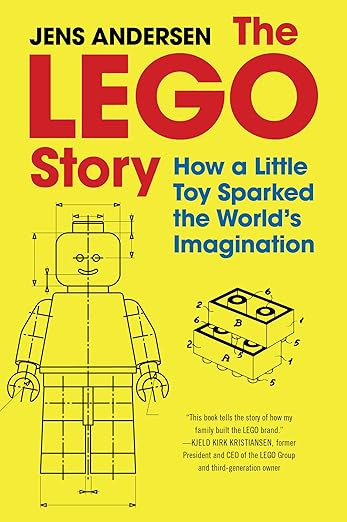It’s estimated that each year between eighty and ninety million children around the globe are given a box of LEGO, while up to ten million adults buy sets for themselves. Yet LEGO is much more than a dizzying number of plastic bricks that can be put together and combined in countless ways. LEGO is also a vision of the significance of what play can mean for humanity.
This book tells the extraordinary story of a global company and a Danish family who for ninety years have defended children’s right to play—and who believe grown-ups, too, should make the time to nurture their inner child. The LEGO Story is built on Jens Andersen’s unique access to LEGO’s own archives, as well as on Andersen’s extensive conversations with Kjeld Kirk Kristiansen, former president and CEO of the LEGO group and grandson of its founder, Ole Kirk Christiansen.
A riveting cultural history of changing generations’ views of childhood and the importance of play, The LEGO Story also a fascinating case study of how innovation and creativity helped leaders transform LEGO from a small carpentry business into the world’s largest producer of play materials and one of the most beloved brands in the world. Richly illustrated with never-before-seen photos from the family’s private archive, this is the ultimate book for fans of LEGO, revealing everything you ever wanted to know about the brand.
Some Big Ideas from the book:
The Power of Creativity and Imagination: LEGO’s success is rooted in its ability to inspire creativity and imagination. The company’s simple yet versatile design allowed children (and adults) to build anything they could imagine, fostering endless creativity. The lesson here is that products that encourage creativity can have lasting appeal and a deep connection with their users.
Embrace Change and Innovation: Throughout the book, one of the key themes is how LEGO adapted to changing times, market demands, and technological advancements. From shifting focus to different product lines like LEGO Technic and LEGO Friends to introducing video games and movies, LEGO continuously innovated to stay relevant. The idea is that companies must constantly evolve to remain competitive and meet the changing needs of their customers.
Focus on Core Values: Despite the ups and downs of the business, LEGO remained focused on its core values: creativity, quality, and fun. These values were consistently reflected in every product they created. The takeaway is that businesses should stay true to their core values, even as they adapt and grow.
Responding to Failure: LEGO faced several financial crises, especially during the late 1990s and early 2000s when it expanded too quickly and deviated from its core. However, the company recovered by cutting back on unprofitable lines and refocusing on what made LEGO great. The lesson is that failure is not the end but an opportunity to reassess and refocus.
Understanding the Customer: LEGO recognized the importance of understanding its customers. The company knew that the key to success lay in connecting with the children who played with the toys and the parents who bought them. The idea is that successful companies always stay in tune with their customers’ needs and desires.
Leveraging Partnerships: Strategic partnerships played a pivotal role in LEGO’s success. From collaborations with Disney for licensed products (e.g., LEGO Star Wars) to working with the digital world, LEGO embraced partnerships to expand its brand and reach new audiences. This teaches that leveraging partnerships can open up new revenue streams and customer bases.
A Strong Brand Identity: LEGO developed a strong, recognizable brand identity over decades. The book demonstrates how maintaining a consistent brand story and message helped the company build loyalty and recognition around the world. This emphasizes the importance of building a powerful, clear, and consistent brand identity.
Sustainability and Long-Term Thinking: LEGO’s commitment to sustainability, including their initiative to create bricks made from sustainable materials, shows the importance of long-term thinking. The lesson here is that businesses need to think











